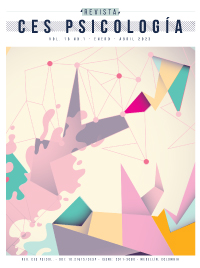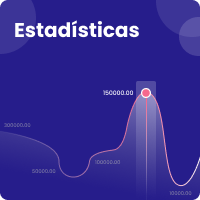Adicción a Internet: relación con la ansiedad, la depresión, el estrés y el tiempo en línea
DOI:
https://doi.org/10.21615/cesp.6255Palabras clave:
adicción a internet, uso de internet, medios de comunicación social, ansiedad, depresión, estrés, tiempo en línea, adolescencia, estudiantes universitariosResumen
Este estudio analiza la relación entre la adicción a internet, la ansiedad, la depresión, el estrés y el tiempo recreativo dedicado a Internet por día. Participaron 1050 universitarios portugueses, de entre 17 y 35 años, 633 mujeres y 417 hombres, a quienes se les aplicaron los siguientes instrumentos: cuestionario sociodemográfico, Internet Addition Test (IAT) y la Escala de Ansiedad, Depresión y Estrés (EADS 21). Los resultados indican que los individuos más adictos a internet presentan valores más altos en las variables ansiedad, depresión y estrés. El tiempo de ocio en línea tuvo un efecto estadísticamente significativo sobre la adición a internet. Este estudio tiene implicaciones para el abordaje de los servicios de salud universitarios, concretamente en términos de prevención e intervención en esta problemática, además de resaltar la importancia de un adecuado manejo de las emociones como factor preventivo.
Descargas
Referencias bibliográficas
Andreou, E., & Svoli, H. (2013). The association between internet user characteristics and dimensions of internet addition among greek adolescents. Journal of Mental Health Addition, 11, 139-148. https://doi.org/10.1007/s11469-012-9404-3
Akin, A., & Iskender, M. (2011). Internet addition and depression, ansiety and stress. International Online Journal of Educational Sciences, 3(1), 138-148. https://iojes.net/?mod=makale_tr_ozet&makale_id=41313
Bahrainian, S. A., Alizadeh, K. H., Raeisoon, M. R., Gorji, O. H., & Khazaee, A. (2014). Relationship of Internet addiction with self-esteem and depression in university students. Journal of preventive medicine and hygiene, 55(3), 86–89. https://www.ncbi.nlm.nih.gov/pmc/articles/PMC4718307/
Bányai, F., Zsila À., Király O., Maraz A., Elekes Z., Griffiths. M., Andreassen, C., & Demetrovics, Z. (2017). Problematic Social Media Use: Results from a Large-Scale Nationally Representative Adolescent Sample. Plos One, 12(1), 1-13. https://doi.org/10.1371/journal.pone.0169839
Bessière, K., Kiesler, S., Kraut, R., & Boneva, B. (2008). Effects of internet use and social resources on changes in depression. Information, Communication & Society, 11(1), 47-70. https://doi.org/10.1080/13691180701858851
Beavers, L., Bell, R., Choudhury, D., Guyot, W., & Meier, R. (2015). Online time and gender perceptions of internet addiction. Journal of Higher Education Theory and Practice, 15(3), 84-98. https://ssrn.com/abstract=2584540
Buckner, J., Castille, C., & Sheets, T. (2012). The five factor model of personality and employees excessive use of technology. Computers in Human Behavior, 28, 1947-1953. https://doi.org/10.1016/j.chb.2012.05.014
Busari, A. (2016). Academic Stress and Internet Addition among adolescents: solution focused social interest programme as treatment option. Journal of Mental Disorders Treatment, 2(2), 1-10. https://doi.org/10.4172/2471-271X.1000114
Caplan, S. E., & High, A. C. (2011). Online social interaction, psychosocial well-being, and problematic Internet use. In K. S. Young & C. N. de Abreu (Eds.), Internet addiction: A handbook and guide to evaluation and treatment (pp. 35–53). John Wiley & Sons, Inc.
Carli, V., Durkee, T., Wasserman, D., Hadlaczky, G., Despalins, R., Kramarz, E., Wasserman, C., Sarchiapone, M., Hoven, W., Brunner, R., & Kaess, M. (2013). The association between pathological internet use comobid psychopathology: a systematic review. Psychopathology, 46(2), 1-13. https://doi.org/10.1159/000337971
Choi, S. W., Kim, D. J., Choi, J. S., Ahn, H., Choi, E. J., Song, W. Y., Kim, S., & Youn, H. (2015). Comparison of risk and protective factors associated with smartphone addiction and Internet addiction. Journal of behavioral addictions, 4(4), 308-314. https://doi.org/10.1556/2006.4.2015.043
Chou, W-P., Ko, C-H., Kaufman, E., Crowell, S., Hsiao, R., Wang, P-W., Lin, J-J., & Yen, C-F. (2015). Association of stress coping strategies with Internet addition in college students: The moderating effect of depression. Compreensive Psychoterapy, 62, 27-33. https://doi.org/10.1016/j.comppsych.2015.06.004
Cho, S-M., Sung, M_J., Shin, K-M., Lim, K., Shin, Y-M. (2013). Does psychopatology in childhood predict internet addition in male adolescents? Child Psychiatry & Human Development, 44(4), 549-555. https://doi.org/10.1007/s10578-012-0348-4
Davis, R. (2001). A cognitive-behavioral model of pathological internet use. Computers in Human Behavior, 17(2), 187-195. https://doi.org/10.1016/S0747-5632(00)0041-8
Gonidis, L., & Sharma, D. (2017). Internet and Facebook related images affect the perception of time. Journal of Applied Social Psychology, 47, 224-231. https://doi.org/10.1111/jasp.12429
Gholamian, B., Shahnazi, H., & Hassanzadeh, A. (2017). The prevalence of internet addition and its association with depression, anxiety, and stress, among high-school students. International Journal of Pediatrics, 4(40), 4763-4770. https://doi.org/10.22038/IJP.2017.22516.1883
Griffiths, M. D. (2017). Conceptual issues concerning internet Addiction and internet gaming disorder: Further critique on Ryding and Kaye (2017). International Journal of Mental Health Addiction,16, 233- 239. https://doi.org/10.1007/s11469-017-9818-z
Hair, J., Black, W., Babin, B., & Anderson, R. (2009). Multivariate data analysis. Prentice Hall.
Hinić, D., Mihajlović, G., & Ðukić-Dejanović, S. (2010). ‘Internet addiction’ in relation to cognitive or somatic depression. Journal of Cognitive and Behavioral Psychotherapies, 10(2), 187-197.
Jun, S., & Choi, E. (2015). Academic stress and internet addition from general strain theory framework. Computers in Human Behavior, 49, 282-287. https://doi.org/10.1016/j.chb.2015.03.001
Kim, J., Hong, H., Lee, J., & Hyun, M., (2017). Effects of time perspective and self-control on procrastination and internet Addiction. Journal of Behavioral Addictions, 6, 229-236. https://doi.org/10.1556/2006.6.2017.017
Kim, J.H., Seo, M., & David, P. (2015). Alleviating depression only to become problematic mobile phone users: Can face-to-face communication be the antidote? Computers in Human Behavior, 51, 440-447. https://doi.org/10.1016/j.chb.2015.05.030
Ko, C.H., Liu, T.L., Wang, P.W., Chen, C.S., Yen, C.F., & Yen, J.Y. (2014). The exacerbation of depression, hostility, and social anxiety in the course of Internet addiction among adolescents: a prospective study. Comprehensive Psychiatry, 55(6), 1377–1384. https://dx.doi.org/10.1016/j.comppsych.2014.05.003
Kuss, D. J., & Griffiths, M. D. (2017). Social networking sites and addiction: Ten lessons learned. International journal of environmental research and public health, 14(3), 311. https://doi.org/10.3390/ijerph14030311
Kuss, D., Griffiths, M., & Binder, J. (2013). Internet addition in students: prevalence and risk factors. Computers in Human Behavior, 29, 959-96. https://dx.doi.org/10.1016/j.chb.2012.12.024
Lavoie, J., & Pychyl, T. (2001). Cyberslacking and the procrastination superhighway: a we-based survey of online procrastination, attitudes, and emotion. Social Science Computer Review, 19, 431-444. https://doi.org/10.1177/089443930101900403
Lin, M-P., Ko, H-C., & Wu, J. (2011). Prevalence and psychosocial risk factors associated with internet Addition in a nationally representative sample of college students in Taiwan. CyberPsychology, Behavior, and Social Networking, 14(12), 741-746. https://doi.org/10.1089/cyber.2010.0574
Lopez-Fernandez, O., Griffiths, M. D., Kuss, D. J., Dawes, C., Pontes, H. M., Justice, L., Rumpf, H.-J., Bischof, A., Gässler, A.-K., Suryani, E., Männikkö, N., Kääriänen, M., Romo, L., Morvan, Y., Kern, L., Graziani, P., Rousseau, A., Hormes, J. M., Schimmenti, A., … Billieux, J. (2019). Cross-cultural validation of the compulsive ınternet use scale in four forms and eight languages. Cyberpsychology, Behavior, and Social Networking, 22(7), 451–464. https://doi.org/10.1089/cyber.2018.0731
Marôco, J. (2007). Análise estatística com utilização do SPSS (3a ed.). Edições Sílabo.
Marôco, J. (2014). Análise de equações estruturais: Fundamentos teóricos, software & aplicações (2ª ed.). ReportNumber.
Mamun, M. A., Hossain, M. S., Siddique, A. B., Sikder, M. T., Kuss, D. J., & Griffiths, M. D. (2019). Problematic internet use in Bangladeshi students: the role of socio-demographic factors, depression, anxiety, and stress. Asian Journal of Psychiatry, 44, 48-54. https://doi.org/10.1016/j.ajp.2019.07.005
Monteiro, A. P., Sousa, M., & Correia, E. (2020). Adição à Internet e Caraterísticas de Personalidade: Um Estudo com Estudantes Universitários Portugueses. Revista Portuguesa de Educação, 33(2), 159-176. http://doi.org/10.21814/rpe.17699
Moral, M., & Suárez, C. (2016). Factores de riesgo en el uso problemático de internet y del teléfono móvil en adolescentes españoles. Revista Iberoamericana de Psicología y Salud, 7(2), 69-78. https://doi.org/10.1016/j.rips.2016.03.001
Nasaescu, E., Marin-Lopez, I., Llorent, V. J., Ortega-Ruiz, R., & Zych, I. (2018). Abuse of technology in adolescence and its relation to social and emotional competencies, emotions in online communication, and bullying. Computers in Human Behavior, 88, 114-120. https://doi.org/10.1016/j.chb.2018.06.036
Ordem dos Psicólogos Portugueses [OPP]. (2011). Código Deontológico da Ordem dos Psicólogos Portugueses. Publicado na 2ª Série do Diário da República a 20 de abril de 2011.
Pais-Ribeiro, J.L., Honrado, A, & Leal, I. (2004). Contribuição para o estudo da adaptação portuguesa das escalas de Ansiedade, Depressão e Stress (EADS-21) de 21 itens de Lovibond e Lovibond. Psicologia, Saúde & Doenças, 5(2), 229-239.
Pontes, H., Patrão, I., & Griffiths, M. (2014). Portuguese validation of the internet addition test: an empirical study. Journal of behavioral additions, 3(2), 107-114. https://doi.org/10.1556/JBA.3.2014.2.4
Przepiorka, A., Blachnio, A., & Cudo, A. (2019). The role of depression, personality, and future time perspective in internet addiction in adolescents and emerging adults. Psychiatry research, 272, 340-348. https://doi.org/10.1016/j.psychres.2018.12.086
Ramos-Galarza, C., Jadán-Guerrero, J., Paredes-Núñez, L., Bolaños-Pasquel, M., & Gómez-García, A. (2017). Procrastinación, adicción al internet y rendimiento académico de estudiantes universitarios ecuatorianos. Estudios pedagógicos, 43(3), 275-289. https://doi.org/10.4067/S0718-07052017000300016
Razieh, J., Ali, G., Zaman, A., & Narjesskhatoon, S. (2012). The relationship between internet addition and ansiety in the university’s students. Institute of Interdisciplinary Business Research, 4(1), 942-949. https://journal-archieves18.webs.com/942-949.pdf
Romero-Rodríguez, J. M., Martínez-Heredia, N., & Campos, M. (2021). Influencia de la adicción a internet en el bienestar personal de los estudiantes universitarios. Health and Addictions/ Salud y Drogas, 21(1), 171-185. https://doi.org/10.21134/haaj.v21i1.559
Sampieri, R., Collado, C., & Lucio, P. (2014). Metodologia de la investigación (6a ed.). McGraw-Hill Interamericana.
Seki, T., Hamazaki, K., Natori, T., & Inadera, H. (2019). Relationship between internet addiction and depression among Japanese university students. Journal of affective disorders, 256, 668-672.
Sirvidio, R., Gentile, A., & Boca, S. (2018). The mediational role of coping strategies in the relationship between self-esteem and risk of internet addition. European Journal of Psychology, 14(1), 176-187. https://doi.org/10.5964/ejop.v14i1.1449
Taranto, F., Goracci, A., Bolognesi, S., Borghini, E., & Fagiolini, A. (2015). Internet Addition disorders in a sample of 402 high school students. Psychiatric Polish, 49(2), 255-263. https://doi.org/10.12740/PP/32500
Turel, O., Brevers, D., & Bechara, A. (2018). Time distortion when users at-risk for social media addiction engage in non-social media tasks. Journal of psychiatric research, 97, 84-88. https://doi.org/10.1016/j.jpsychires.2017.11.014
Velezmoro, R., Lacefield, K., & Roberti, W. (2010). Perceived stress, sensation seeking, and college students abuse of the internet. Computers in Human Behavior, 26, 1526-1530. https://doi.org/10.1016/j.chb.2010.05.020
Weinstein, A., Dorani, D., Elhadif, R., Bukovza, Y., & Yarmulnik, A. (2015). Internet addiction is associated with social anxiety in young adults. Annals of Clinical Psychiatry, 27(1), 1-6. https://pubmed.ncbi.nlm.nih.gov/25696775/
Wong, T. Y., Yuen, K. S., & Li, W. O. (2015). A basic need theory approach to problematic Internet use and the mediating effect of psychological distress. Frontiers in psychology, 5, 1562. https://doi.org/10.3389/fpsyg.2014.0156
Younes, F., Halawi, G., Jabbour, H., El Osta, N., Karam, L., Hajj, A., & Rabbaa Khabbaz, L. (2016). Internet addiction and relationships with insomnia, anxiety, depression, stress and self-esteem in university students: A cross-sectional designed study. Plos one, 11(9), e0161126. https://doi.org/10.1371/journal.pone.0161126
Young, K. S. (1996). Psychology of computer use: XL: Additive use of internet: A case that breaks the stereotype. Psychology Reports, 79(3), 899-902. https://doi.org/10.2466/pr0.1996.79.3.899
Young, K., & Rodgers, R. (1998). The relationship between depression and internet addition. CyberPsychology and Behavior, 1(1), 25-28. https://doi.org/10.1089/cpb.1998.1.25
Young, K. S. (1999). Internet addiction: Symptoms, evaluation, and treatment. In L. Vandecreek, & T. Jackson (Eds.), Innovations in Clinical Practice: A Source Book (pp. 19-31). Professional Resource Press.
Young, K.S. (2011). CBT-IA: the first treatment model to address internet addition. Journal Cognitive Therapy, 25(4), 304-312. https://doi.org/10.1891/0889-8391.25.4.304
Descargas
Publicado
Cómo citar
Número
Sección
Licencia
Derechos de autor 2023 Ana Paula Monteiro, Manuel Sousa, Elisete Correia

Esta obra está bajo una licencia internacional Creative Commons Atribución-NoComercial-CompartirIgual 4.0.
Revista CES Psicología ISSN 2011 3080
Facultad de Psicología, Universidad CES Primera edición 2008. Última actualización Mayo 18 de 2022. Todos los derechos reservados. Hecho el depósito legal que exige la ley.
Se autoriza la reproducción total o parcial de los artículos citando la fuente y el autor. This publication may be reproduced by mentioning the source and the authors.
| Estadísticas de artículo | |
|---|---|
| Vistas de resúmenes | |
| Vistas de PDF | |
| Descargas de PDF | |
| Vistas de HTML | |
| Otras vistas | |




